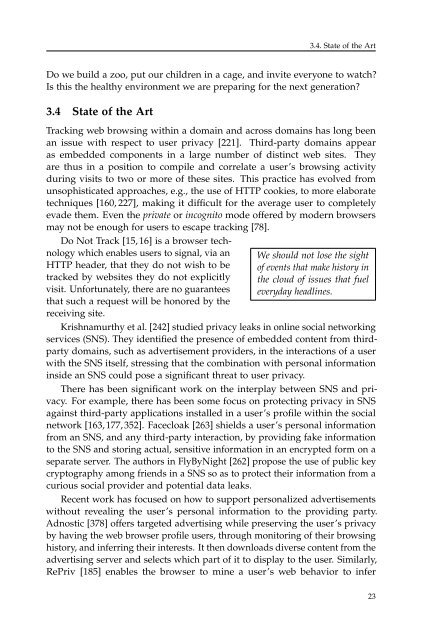syssec_red_book
syssec_red_book
syssec_red_book
You also want an ePaper? Increase the reach of your titles
YUMPU automatically turns print PDFs into web optimized ePapers that Google loves.
3.4. State of the ArtDo we build a zoo, put our children in a cage, and invite everyone to watch?Is this the healthy environment we are preparing for the next generation?3.4 State of the ArtTracking web browsing within a domain and across domains has long beenan issue with respect to user privacy [221]. Third-party domains appearas embedded components in a large number of distinct web sites. Theyare thus in a position to compile and correlate a user’s browsing activityduring visits to two or more of these sites. This practice has evolved fromunsophisticated approaches, e.g., the use of HTTP cookies, to more elaboratetechniques [160, 227], making it difficult for the average user to completelyevade them. Even the private or incognito mode offe<strong>red</strong> by modern browsersmay not be enough for users to escape tracking [78].Do Not Track [15, 16] is a browser technologywhich enables users to signal, via anHTTP header, that they do not wish to betracked by websites they do not explicitlyvisit. Unfortunately, there are no guaranteesthat such a request will be hono<strong>red</strong> by thereceiving site.We should not lose the sightof events that make history inthe cloud of issues that fueleveryday headlines.Krishnamurthy et al. [242] studied privacy leaks in online social networkingservices (SNS). They identified the presence of embedded content from thirdpartydomains, such as advertisement providers, in the interactions of a userwith the SNS itself, stressing that the combination with personal informationinside an SNS could pose a significant threat to user privacy.There has been significant work on the interplay between SNS and privacy.For example, there has been some focus on protecting privacy in SNSagainst third-party applications installed in a user’s profile within the socialnetwork [163, 177, 352]. Facecloak [263] shields a user’s personal informationfrom an SNS, and any third-party interaction, by providing fake informationto the SNS and storing actual, sensitive information in an encrypted form on aseparate server. The authors in FlyByNight [262] propose the use of public keycryptography among friends in a SNS so as to protect their information from acurious social provider and potential data leaks.Recent work has focused on how to support personalized advertisementswithout revealing the user’s personal information to the providing party.Adnostic [378] offers targeted advertising while preserving the user’s privacyby having the web browser profile users, through monitoring of their browsinghistory, and inferring their interests. It then downloads diverse content from theadvertising server and selects which part of it to display to the user. Similarly,RePriv [185] enables the browser to mine a user’s web behavior to infer23


